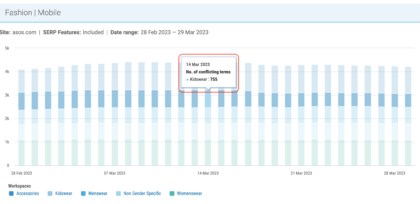SEO Cannibalisation
SEO cannibalization is a form of SEO conflict when multiple pages within your site, or across domains, are competing for the same search term. It’s an issue which can affect search rankings, but one that we can identify and fix.
What is cannibalization and why is it important in SEO?
SEO Cannibalisation is an issue which can adversely affect search rankings, and one which many sites may be unaware of.
Cannibalisation occurs when two or more pages within a site compete to return for the same search.
The conflict occurs when there is duplicate theming and Google cannot determine which page should appear for the given term.
This often occurs for quite general terms that don’t lead to a well-themed landing page, but can also transpire when link architecture is suboptimal, and a lower authority page becomes more prominent than the primary landing page.
It can affect ecommerce sites selling thousands of products, many of which are similar, or for publishers covering topics over many different articles and pages.
These sites tend to have product pages, new articles and site sections which use the same keywords multiple times. For example, a fashion ecommerce site will have multiple pages containing coats, or a news site will have lots of articles about a topic like Brexit.
There are three main types of SEO cannibalisation which can affect businesses:
- Keyword cannibalisation: This is when multiple pages on the same website are competing for the same term.
- Subdomain conflict: Many brands use subdomains, whether it’s to separate content based on audience, to break up different budgets by department, or to gain more positions in the SERPs. Subdomain SEO cannibalisation can occur when different departments are focusing on the same content, especially if their focus search term is very general.
- Semantic flux between family site: Family owned brands that share duplicate content, or brands that have their content repurposed externally, are typically those who fall victim to semantic flux. We have seen semantic flux between many big-name family brands. Search engines register similar content shared between these family brands and treats them, ostensibly, as the same domain; giving positions to just one at a time. We’ve even seen unrelated brands suffer from semantic flux.
Without organisation and planning, this conflicting content means that Google and other search engines aren’t able to determine which page should rank from your site for a term, so it chooses the one it thinks most relevant at the time.
The result is often that the page doesn’t appear on Google at all, or at least not consistently, and that your overall rankings for the term drop.
The good news is that cannibalisation problems can be addressed. The first step is to identify any cannibalization issues, using SEO tracking software like PI to identify content conflict.
Once you have done this, it’s about deciding which pages you want to rank for each term. In some cases this may be the most profitable producing landing page, the most relevant category page for users, or a hub page for content sites which holds like to all of the relevant content for each search term.
A well-planned internal linking strategy is most often the solution. Directing links to the target pages sends clear signals to Google about the page you want to rank for the target term, and helps users to find the most relevant content.








